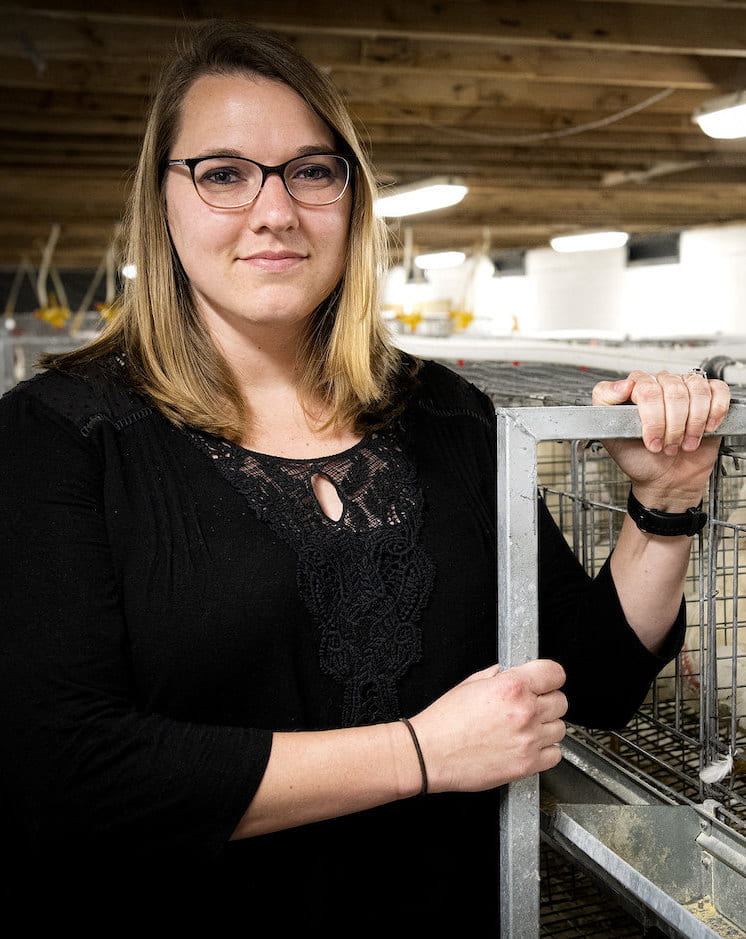Chickens Selectively Bred for Water Efficient Traits


Sara Orlowski
Assistant Professor of Poultry Science
The Problem
Chickens are the world’s number one livestock animal, but they use a lot of water.
About 4 billion people in the world experience freshwater scarcity for at least one month each year, according to a United Nations report. The strain on water will increase into 2050 as the population reaches an estimated 9.7 billion people. A growing population also increases the demand for food and adds another strain on finite water resources.
The Work
Sara Orlowski, assistant professor of poultry science, is breeding her fourth generation of genetically selected broiler chickens to develop a more water-efficient chicken breed without weight-gain reduction.
For the project, Orlowski breeds two groups: one group for higher water efficiency and one for lower water efficiency. A third group is bred randomly to serve as a control group. The chickens in the first group are selected for how little water they drink for each pound of weight gain. The second group is bred for lower water efficiency — i.e., they drink more water per pound of weight gain.
To measure individual water consumption, which is difficult to do in the low-flow systems used to provide water to poultry, Orlowski and others in a graduate research team developed a novel low-flow water monitoring system for use with poultry. It has allowed her to accurately track water intake for each bird.
NOT THIRSTY — Sara Orlowski, assistant professor of poultry science, is selecting broilers for water efficiency. Her aim is to breed for birds that maintain consistent feed conversion and weight gain while consuming less water. (U of A System Division of Agriculture photo by Fred Miller)
The Results
So far, Orlowski has found that the broilers in the first group have maintained consistent body weight. Feed conversion in those broilers was not impacted by the lower water intake. The less water-efficient broilers in the second group consumed more water without improving weight gain. The randomly bred boilers in the control group consumed an amount of water between the test groups.
If the fourth-generation broilers stay consistent with her findings, the next part of the study will be to examine if the changes in water efficiency cause physiological effects on gut health and integrity, breast meat yield changes, or if there are any other impacts on the birds’ health.
Orlowski and Shawna Weimer, assistant professors of animal science and director of the Center for Food Animal Wellbeing, will investigate how the birds from each group use water and what sets the more efficient users ahead of the others. They will also evaluate if environmental conditions change the levels of efficiency.
The Value
This might be the first time anyone has looked at improving water use efficiency in poultry, said Walter Bottje, professor of poultry science for the Arkansas Agricultural Experiment Station.
The selectively bred chickens have shown positive results in consistent body weight and reduced water consumption. This project could result in selectively bred broilers that can thrive on limited water while providing protein that will meet future demands.
So far in the study, Orlowski has found that the high-efficiency broilers consumed approximately 0.4 gallons less water in their lifetime than the low-efficiency broilers—about a 20% decrease in water consumption.
In the U.S., there were 9.22 billion broilers produced in 2020, according to the United States Department of Agriculture. Arkansas accounted for approximately 1 billion of those broilers, according to The Poultry Federation.
Eventually, these single-trait-selected broilers could be introduced to a primary breeder company, which selects the lines of broilers available to the industry. Additionally, Orlowski hopes the low-flow water monitoring technology can be implemented by these breeder companies so they can also incorporate water intake into their trait evaluations.
The Funding
The research is part of a five-year, multi-institution project funded by a $9.9 million U.S. Department of Agriculture National Institute of Food and Agriculture grant. The grant was awarded through NIFA’s Agriculture and Food Research Initiative.
The development of the low-flow water monitoring technology is supported by Cobb-Vantress, Inc., a Siloam Springs-based primary broiler breeder company.
About the Researcher

Sara Orlowski
Assistant Professor of Poultry Science
Arkansas Cooperative Extension Service
- B.S., Agriculture Sciences and Animal Science, Cornell University
- M.S., Poultry Science-Genetics, University of Arkansas
- Ph.D., Poultry Science-Genetics/Management, University of Arkansas
Orlowski’s research focuses on broiler health, meat quality, breast meat yield, and broiler genetics. Her investigations have included the effects of embryonic thermal manipulation, effects of pre-slaughter meat transportation, skeletal integrity of broilers, and the effects of feed and water in broiler chickens.
